�
Numerical Grid Generation: Foundations and Applications
Joe F. Thompson, Z. U. A. Warsi and C. W. Mastin
Format: Paperback, English, 483 pages
ISBN: 044400985X
Publisher: North Holland
Publish Date: 1985
PREFACE
Numerical grid generation has now become a fairly common tool for use in the
numerical solution of partial differential equations on arbitrarily shaped regions. This is
especially true in computational fluid dynamics, from whence has come much of the impetus
for the development of this technique, but the procedures are equally applicable to all
physical problems that involve field solutions. Numerically generated grids have provided
the key to removing the problem of boundary shape from finite difference methods, and
these grids also can serve for the construction of finite element meshes. With such grids all
numerical algorithms, finite difference or finite element, are implemented on a square grid in
a rectangular computational region regardless of the shape and configuration of the physical
region. (Finite volume methods are effectively a type of conservative finite difference
method on these grids.)
In this text, grid generation and the use thereof in numerical solutions of partial
equations are both discussed. The intent was to provide the necessary basic information,
from both the standpoint of mathematical background and from that of coding
implementation, for numerical solutions of partial differential equations to be constructed on
general regions. Since these numerical solutions are ultimately constructed on a square grid
in a rectangular computational region, any solution algorithm that can treat equations with
variable coefficients is basically applicable, and therefore discussion of specific algorithms is
left to classical texts on the numerical solution of partial differential equations.
The area of numerical grid generation is relatively young in practice, although its roots
in mathematics are old. This somewhat eclectic area involves the engineer’s feel for physical
behavior, the mathematician’s understanding of functional behavior, and a lot of
imagination, with perhaps a little help from Urania. The physics of the problem at hand must
ultimately direct the grid points to congregate so that a functional relationship on these
points can represent the physical solution with sufficient accuracy. The mathematics controls
the points by sensing the gradients in the evolving physical solution, evaluating the accuracy
of the discrete representation of that solution, communicating the needs of the physics to the
points, and by providing mutual communication among the points as they respond to the
physics.
Numerical grid generation can be thought of as a procedure for the orderly distribution
of observers, or sampling stations, over a physical field in such a way that efficient
communication among the observers is possible and that all physical phenomena on the
entire continuous field may be represented with sufficient accuracy by this finite collection
of observations. The structure of an intersecting net of families of coordinate lines allows the
observers to be readily identified in relation to each other, and results in much more simple
coding than would the use of a triangular structure or a random distribution of points. The
grid generation system provides some influence of each observer on the others, so that if one
moves to get into a better position for observation of the solution, its neighbors will follow to
some extent in order to maintain smooth coverage of the field.
Another way to think of the grid is as the structure on which the numerical solution is
built. As the design of the lightest structure requires consideration of the load distribution, so
the most economical distribution of grid points requires that the grid be influenced by both
the geometric configuration and by the physical solution being done thereon. In any case,
since resources are limited in any numerical solution, it is the function of the numerical grid
generation to make the best use of the number of points that are available, and thus to make
the grid points an active part of the numerical solution.
�
This is a rapidly developing area, being now only about ten years old, and thus is still
in search of new ideas. Therefore no book on the subject at this time could possibly be
considered to be definitive. However, enough material has now accumulated in the literature,
and enough basic concepts have emerged, that a fundamental text is now needed to meet the
needs of the rapidly expanding circle of interest in the area. It is with the knowledge of both
these needs and these limitations that this text has been written. Some of the techniques
discussed will undoubtedly be superceded by better ideas, but the fundamental concepts
should serve for understanding, and hopefully also for some inspiration, of new directions.
The only background assumed of the student is a senior-level understanding of numerical
analysis and partial differential equations. Concepts from differential geometry and tensor
analysis are introduced and explained as needed.
Numerical grid generation draws on various areas of mathematics, and emphasis
throughout is placed on the development of the relations involved, as well as on the
techniques of application. This text is intended to provide the student with the understanding
of both the mathematical background and the application techniques necessary to generate
grids and to develop codes based on numerically generated grids for the numerical solution
of partial differential equations on regions of arbitrary shape.
The writing of this text has been a cooperative effort over the last two years, spurred
on by the institution of a graduate course in numerical grid generation, as well as an annual
short course, at Mississippi State. The students in both of these courses have contributed
significantly in revising the text as it evolved. The last appendix is the result of a class
assignment prepared by Col. Hyun Jin Kim, graduate student in the computational fluid
dynamics program, who also compiled the index. Our colleage, Dr. Helen V.
McConnaughey of Mathematics contributed significantly through continual discussions and
wrote most of Chapter IV.
We are indebted to a large number of former students and fellow researchers around
the world for the development of the ideas that have crystallized into numerical grid
generation. The complete debt can be acknowledged only through mention of the
bibliographies contained in the several surveys cited herein. A list here would either be too
long to note the strongest influences or too short to acknowledge all the significant ones. We
must, however, acknowledge the many long and fruitful discussions with Peter Eiseman of
Columbia University.
0f vital importance is the support that has been provided for the research from which
the developments discussed in this book have emerged, including NASA; the research
offices of the Air Force, Army, and Navy; the National Science Foundation, and various
industrial concerns. The interest and contributions of a number of contract monitors has been
essential over the years. We are especially appreciative of Bud Bobbitt and Jerry South of
NASA Langley Research Center, who provided the initial support for an unknown with an
idea.
Particular debts are owed to W. H. Chu for an idea in the Journal of Computational
Physics in 1971, and to Frank Thames who put the idea into a dissertation.
In the preparation of the text we had the conscientious and untiring efforts of two most
able secretaries, Rita Curry and Susan Triplett, who typed on in good spirits through a year
of numerous revisions and frustrations as the text evolved.
Finally, we were particularly fortunate to have the services of Yeon Seok Chae,
graduate student in the computational fluid dynamics program and illustrator par excellence,
who did all the figures with understanding of the intended meaning as well as artistic
competence. His meticulous efforts were extensions of our thoughts.
�
Joe F. Thompson
Z. U. A. Warsi
C. Wayne Mastin
Mississippi State, Mississippi
January 1985
�
I. INTRODUCTION
The numerical solution of partial differential equations requires some discretization of
the field into a collection of points or elemental volumes (cells). The differential equations
are approximated by a set of algebraic equations on this collection, and this system of
algebraic equations is then solved to produce a set of discrete values which approximates the
solution of the partial differential system over the field. The discretization of the field
requires some organization for the solution thereon to be efficient, i.e., it must be possible to
readily identify the points or cells neighboring the computation site. Furthermore, the
discretization must conform to the boundaries of the region in such a way that boundary
conditions can be accurately represented. This organization is provided by a coordinate
system, and the need for alignment with the boundary is reflected in the routine choice of
cartesian coordinates for rectangular regions, cylindrical coordinates for circular regions,
etc., to the extent of the handbook’s resources.
The current interest in numerically-generated, boundary-conforming coordinate
systems arises from this need for organization of the discretization of the field for general
regions, i.e., to provide computationally for arbitrary regions what is available in the
handbook for simple regions. The curvilinear coordinate system covers the field and has
coordinate lines (surfaces) coincident with all boundaries. The distribution of lines should be
smooth, with concentration in regions of strong solution variation, and the system should
ultimately be capable of sensing these variations and dynamically adjusting itself to resolve
them.
A numerically-generated grid is understood here to be the organized set of points
formed by the intersections of the lines of a boundary-conforming curvilinear coordinate
system. The cardinal feature of such a system is that some coordinate line (surface in 3D) is
coincident with each segment of the boundary of the physical region. The use of coordinate
line intersections to define the grid points provides an organizational structure which allows
all computation to be done on a fixed square grid when the partial differential equations of
interest have been transformed so that the curvilinear coordinates replace the cartesian
coordinates as the independent variables.
This grid frees the computational simulation from restriction to certain boundary
shapes and allows general codes to be written in which the boundary shape is specified
simply by input. The boundaries may also be in motion, either as specified externally or in
response to the developing physical solution. Similarly, the coordinate system may adjust to
follow variations developing in the evolving physical solution. In any case, the
numerically-generated grid allows all computation to be done on a fixed square grid in the
�
computational field which is always rectangular by construction.
In the sections which follow, various configurations for the curvilinear coordinate
system are discussed in Chapter II. In general, the computational field will be made
rectangular, or composed of rectangular sub-regions, and a wide variety of configurations is
possible. Coordinate systems may also be generated separately for sub-regions in the
physical plane and patched together to form a complete system for complex configurations.
The basic transformation relations applicable to the use of general curvilinear coordinate
systems are developed in Chapter III; the construction of numerical solutions of partial
differential equations on those systems is discussed in Chapter IV; and consideration is given
in Chapter V to the evaluation and control of truncation error in the numerical
representations.
Basically, the procedures for the generation of curvilinear coordinate systems are of
two general types: (1) numerical solution of partial differential equations and (2)
construction by algebraic interpolation. In the former, the partial differential system may be
elliptic (Chapter VI), parabolic or hyperbolic (Chapter VII). Included in the elliptic systems
are both the conformal (Chapter X), and the quasi-conformal mappings, the former being
orthogonal. Orthogonal systems (Chapter IX) do not have to be conformal, and may be
generated from hyperbolic systems as well as from elliptic systems. Some procedures
designed to produce coordinates that are nearly orthogonal are also discussed. The algebraic
procedures, discussed in Chapter VIII, include simple normalization of boundary curves,
transfinite interpolation from boundary surfaces, the use of intermediate interpolating
surfaces, and various other related techniques.
Coordinate systems that are orthogonal, or at least nearly orthogonal near the
boundary, make the application of boundary conditions more straightforward. Although
strict orthogonality is not necessary, and conditions involving normal derivatives can
certainly be represented by difference expressions that combine one-sided differences along
the line emerging from the boundary with central expressions along the boundary, the
accuracy deteriorates if the departure from orthogonality is too large. It may also be more
desirable in some cases not to involve adjacent boundary points strongly in the
representation, e.g., on extrapolation boundaries. The implementation of algebraic turbulence
models is more reliable with near-orthogonality at the boundary, since information on local
boundary normals is usually required in such models. The formulation of boundary-layer
equations is also much more straightforward and unambiguous in such systems. Similarly,
algorithms based on the parabolic Navier-Stokes equations require that coordinate lines
approximate the flow streamlines, and the lines normal thereto, especially near solid
boundaries. It is thus better in general, other considerations being equal, for coordinate lines
to be nearly normal to boundaries.
Finally, dynamically-adaptive grids are discussed in Chapter XI. These grids
continually adapt during the course of the solution in order to follow developing gradients in
the physical solution. This topic is at the frontier of numerical grid generation and may well
prove to be one of its most important aspects.
The emphasis throughout is on grids formed by the intersections of coordinate lines of
a curvilinear coordinate system, as opposed to the covering of a field with triangular
�
elements or a random distribution of points. Neither of these latter collections of points is
suitable for really efficient numerical solutions (although numerical representations can be
constructed on each, of course) because of the cumbersome process of identification of
neighbors of a point and the lack of banded structure in the matrices. Thus the subject of
triangular mesh generators, per se, is not addressed here. (Obviously a triangular mesh can
be produced by construction rectangular mesh diagonals.)
Considerable progress is being made toward the development of the techniques of
numerical grid generation and toward casting them in forms that can be readily applied. A
comprehensive survey of numerical grid generation procedures and applications thereof
through 1981 was given by Thompson, Warsi, and Mastin in Ref. [1], and the conference
proceedings published as Ref. [2] contains a number of expository papers on the area, as
well as current results. Other collections of papers on the area have also appeared (Ref. [3]
and [4]), and a later review through 1983 has been given by Thompson in Ref. [5]. Some
other earlier surveys are noted in Ref. [1]. A later survey by Eiseman is given in Ref. [37].
The present text is meant to be a developmental treatment of the techniques of grid
generation and its applications, not a survey of results, and therefore no attempt is made here
to cite all related references, rather only those needed to illustrate particular points are noted.
The surveys mentioned above should be consulted directly for references to examples of
various applications and related contributions. (Ref [l] gives a short historical development
of the ideas of grid generation.) Other surveys of particular areas of grid generation are cited
later as topics are introduced.
Finally, in regard to implementation, a configuration for the transformed
(computational) field is first established as discussed in Chapter II. The grid is generated
from a generation system constructed as discussed in Chapters VI -- X. (If the grid is to be
adaptive, i.e., coupled with the physical solution done thereon, then the gr1d must be
continually updated as discussed in Chapter XI.) In the construction of the grid, due account
must be taken of the truncation error induced by the grid discussed in Chapter V. The partial
differential equations of the physical problem of interest are transformed according to the
relations given in Chapter III. These transformed equations are then discretized, cf. Chapter
IV, and the resulting set of algebraic equations is solved on the fixed square grid in the
rectangular transformed field.
�
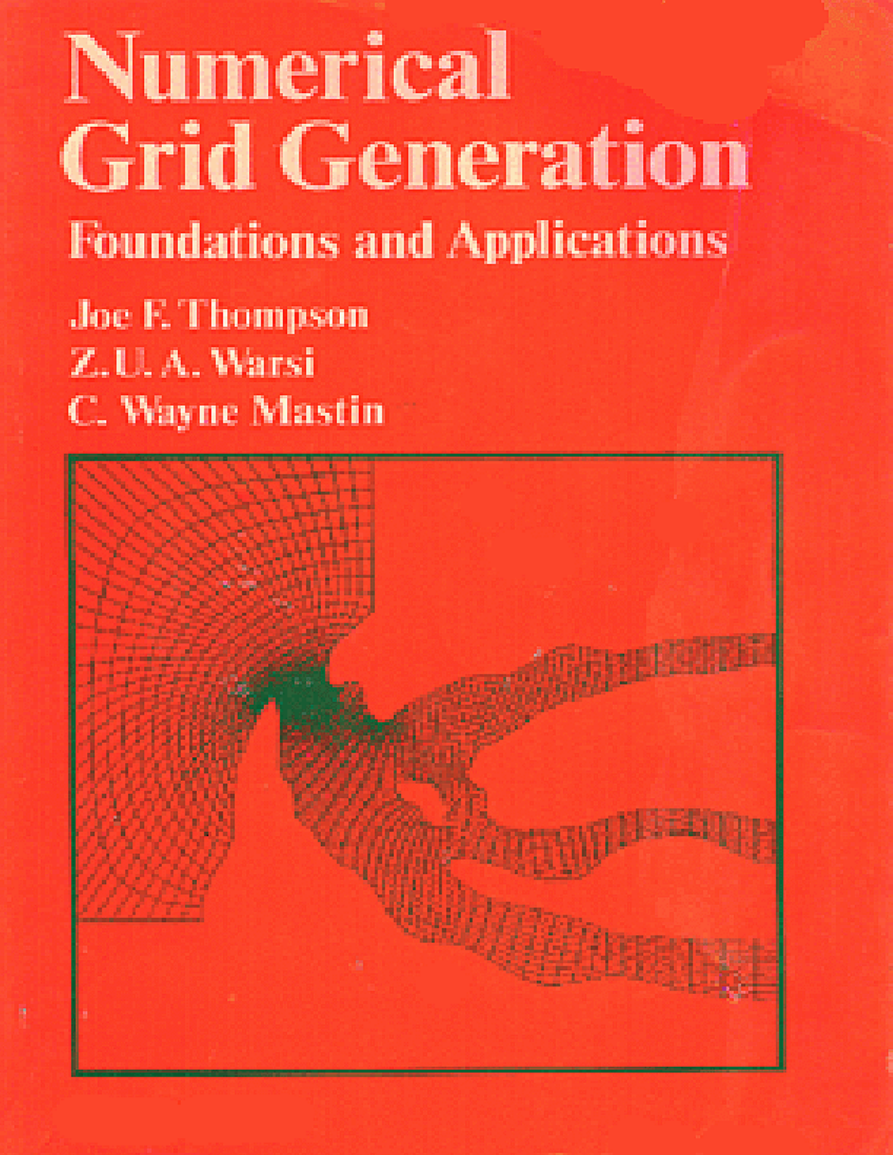

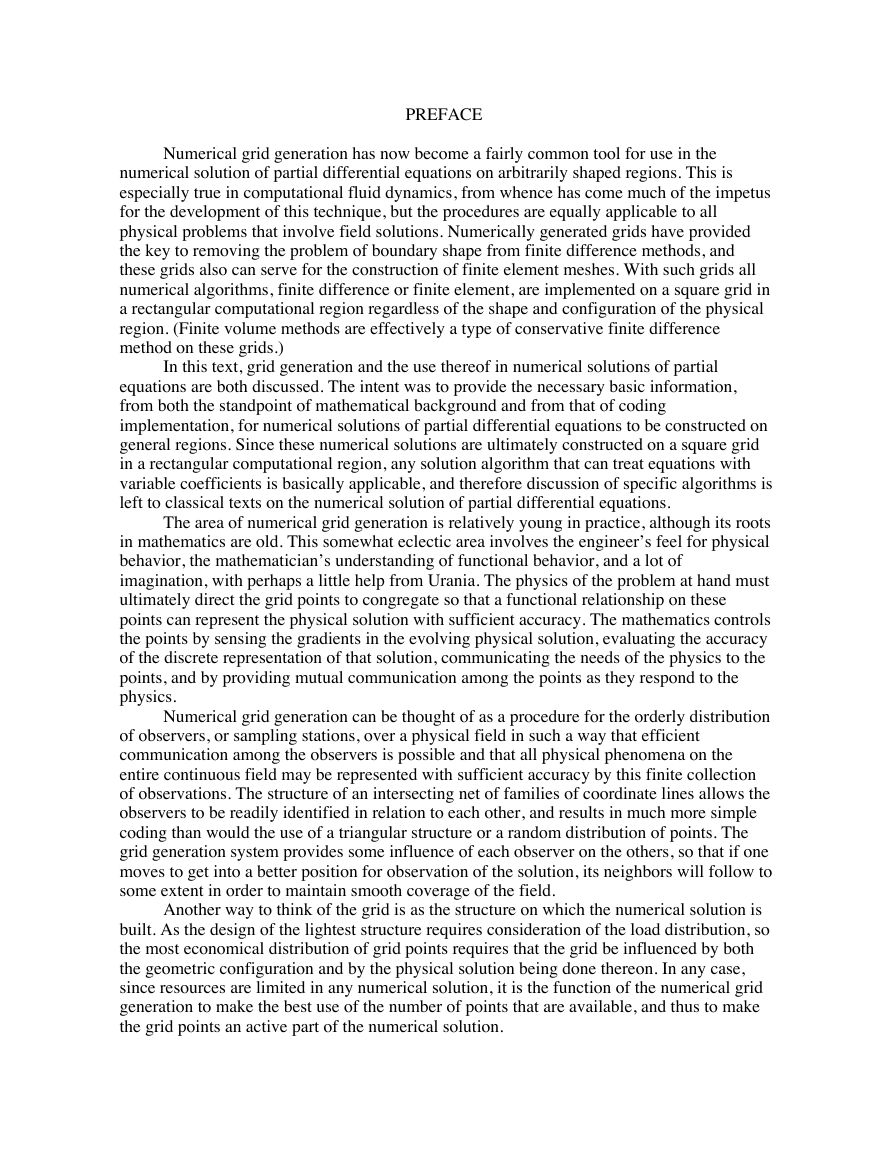


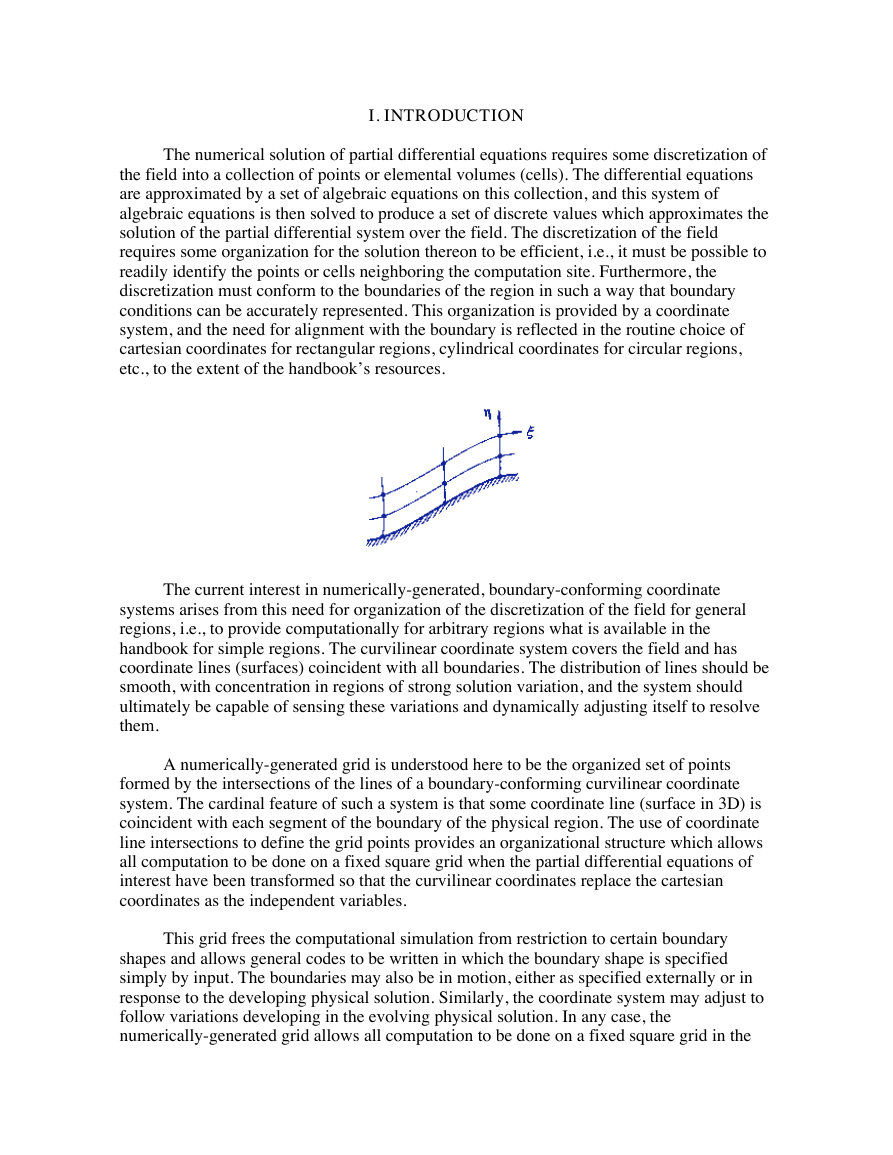
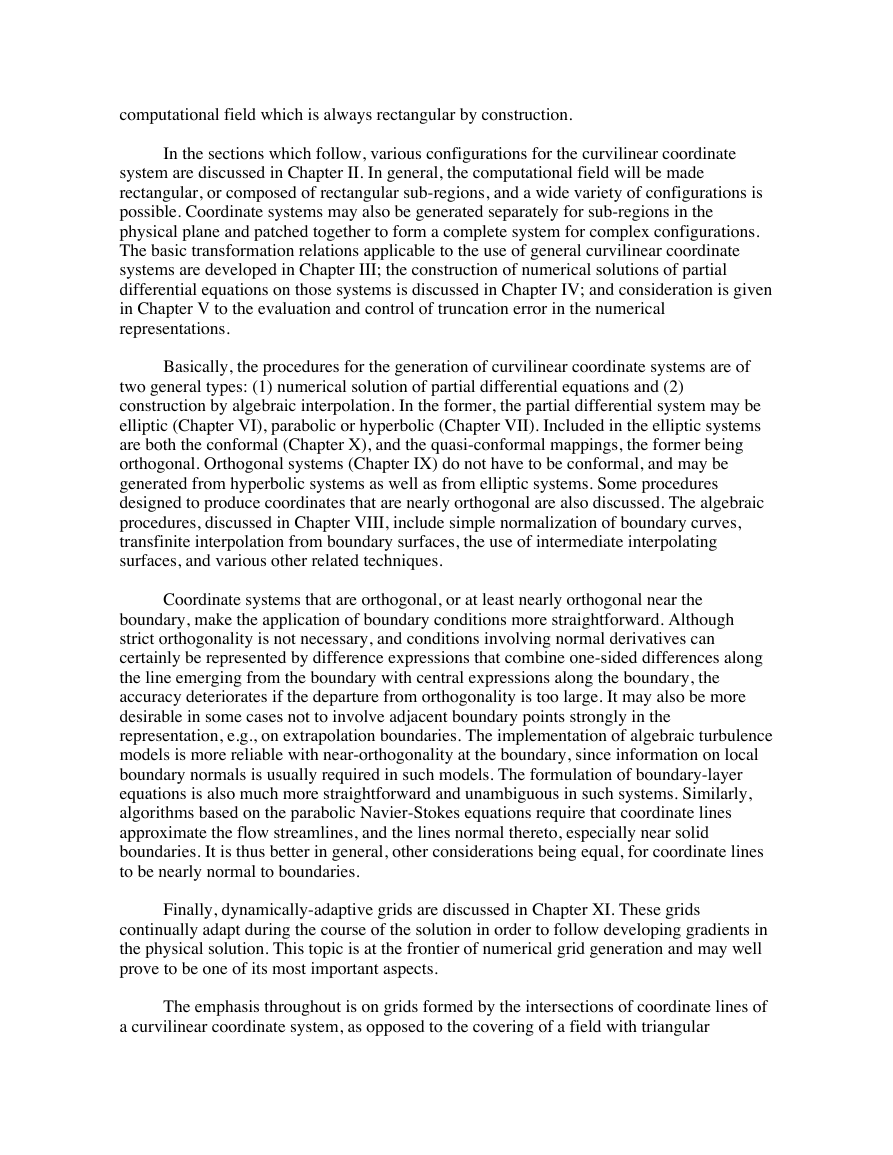
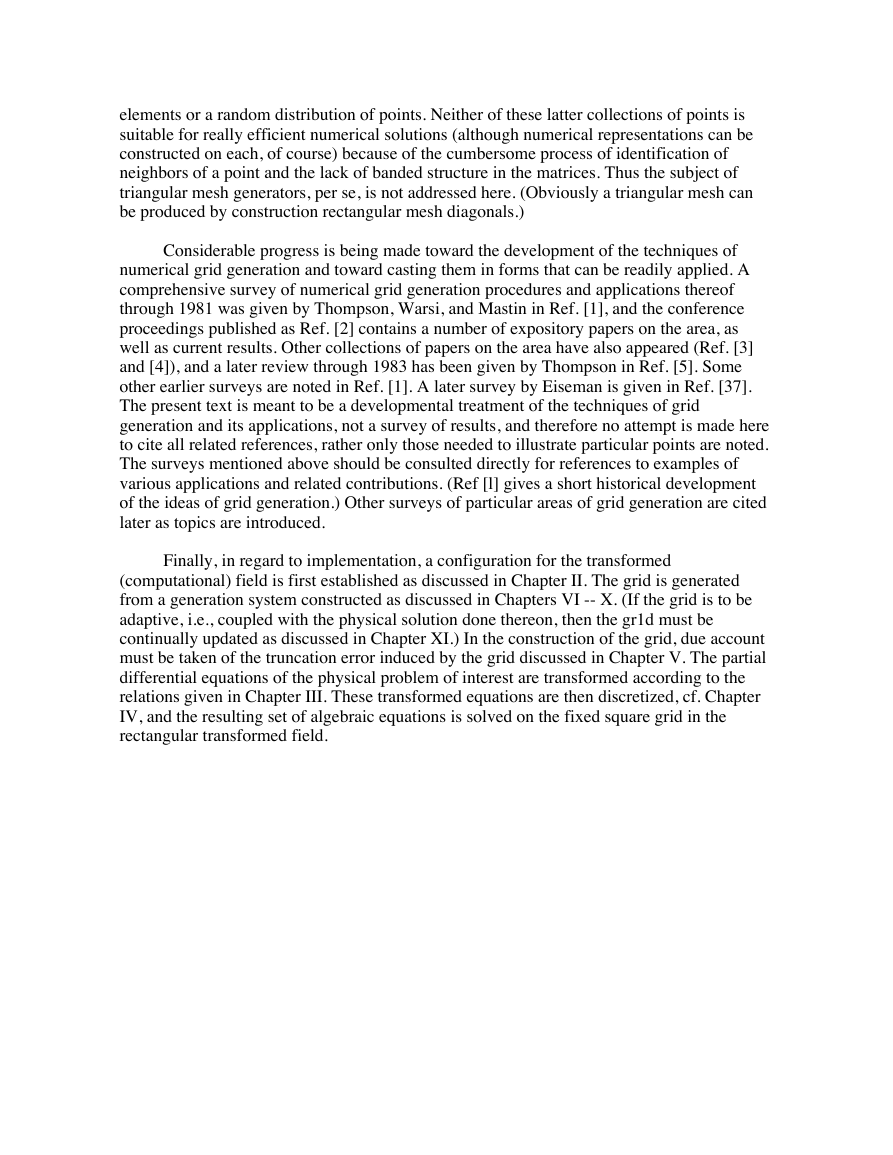








 2023年江西萍乡中考道德与法治真题及答案.doc
2023年江西萍乡中考道德与法治真题及答案.doc 2012年重庆南川中考生物真题及答案.doc
2012年重庆南川中考生物真题及答案.doc 2013年江西师范大学地理学综合及文艺理论基础考研真题.doc
2013年江西师范大学地理学综合及文艺理论基础考研真题.doc 2020年四川甘孜小升初语文真题及答案I卷.doc
2020年四川甘孜小升初语文真题及答案I卷.doc 2020年注册岩土工程师专业基础考试真题及答案.doc
2020年注册岩土工程师专业基础考试真题及答案.doc 2023-2024学年福建省厦门市九年级上学期数学月考试题及答案.doc
2023-2024学年福建省厦门市九年级上学期数学月考试题及答案.doc 2021-2022学年辽宁省沈阳市大东区九年级上学期语文期末试题及答案.doc
2021-2022学年辽宁省沈阳市大东区九年级上学期语文期末试题及答案.doc 2022-2023学年北京东城区初三第一学期物理期末试卷及答案.doc
2022-2023学年北京东城区初三第一学期物理期末试卷及答案.doc 2018上半年江西教师资格初中地理学科知识与教学能力真题及答案.doc
2018上半年江西教师资格初中地理学科知识与教学能力真题及答案.doc 2012年河北国家公务员申论考试真题及答案-省级.doc
2012年河北国家公务员申论考试真题及答案-省级.doc 2020-2021学年江苏省扬州市江都区邵樊片九年级上学期数学第一次质量检测试题及答案.doc
2020-2021学年江苏省扬州市江都区邵樊片九年级上学期数学第一次质量检测试题及答案.doc 2022下半年黑龙江教师资格证中学综合素质真题及答案.doc
2022下半年黑龙江教师资格证中学综合素质真题及答案.doc